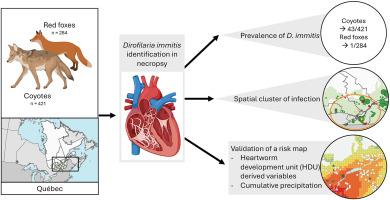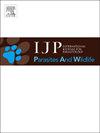Prevalence, spatial distribution and risk mapping of Dirofilaria immitis in wild canids in southern Québec, Canada
Abstract
Domestic dogs (Canis familiaris) and wild canids, including coyotes (Canis latrans) and red foxes (Vulpes vulpes), serve as definitive hosts for Dirofilaria immitis, a parasitic nematode causing the heartworm disease. Understanding infection risks in wildlife reservoirs in relation to environmental factors is crucial for assessing exposure risk in domestic dogs. The regional prevalence of D. immitis infection was estimated in trapped wild coyotes and red foxes across Québec, Canada. Spatial clusters of infection were detected using Kulldorff's spatial scan statistics. A series of logistic regression models predicting the D. immitis status in coyotes were built from heartworm development unit (HDU) estimates and cumulative precipitation variables over various time periods. Between October 2020 and March 2021, 421 coyotes and 284 red foxes were examined for the presence of D. immitis. The parasite was found in 43 coyotes and 1 red fox. A high-risk infection cluster was detected in coyotes in southwestern Québec. The best model included as sole predictor the average cumulative HDU contributing to risk of D. immitis in the three years preceding coyote capture. This model significantly predicted infection status with an area under the curve of 76.1%. The cumulative precipitation had no notable effect in any model. This study highlights a high prevalence of D. immitis in coyotes in Québec with regional differences correlated to temperature-derived predictors. The spatial risk of infection in this population likely represents the environmental risk of exposure to the parasite given that coyotes do not receive preventive treatment compared to domestic dogs. Our findings are important for veterinarians in the application of prevention strategies for heartworm disease in domestic dogs.


 求助内容:
求助内容: 应助结果提醒方式:
应助结果提醒方式:


